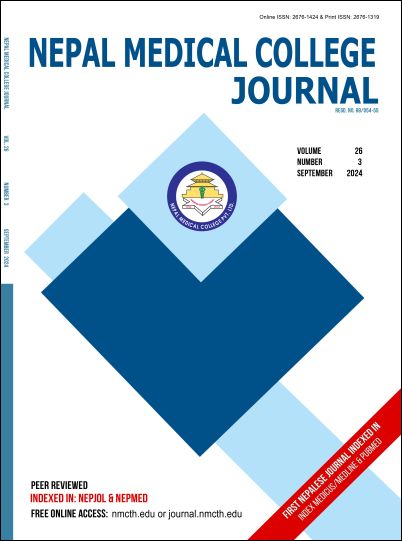Profile of Glaucoma Patients at a Tertiary Care Centre in Gokarneshwor, Kathmandu, Nepal
DOI:
https://doi.org/10.3126/nmcj.v26i3.69880Keywords:
Glaucoma, prevalence, open angle glaucoma, angle closure glaucomaAbstract
Glaucoma is a progressive optic neuropathy characterized by irreversible optic nerve damage and progressive visual field loss. It is the second leading cause of global irreversible blindness. The objective of this study was to find the prevalence, clinical profile and distribution of various types of glaucoma in patients attending a tertiary care center of Kathmandu. This was a retrospective, descriptive hospital based study conducted at glaucoma clinic at tertiary care center from March 2022 to February 2024 (24 months). Patients’ demographic profile along with comprehensive eye examination findings were reviewed from the records. Data analysis was done with SPSS version 18 and chi-square test was used for analysis. P value <0.05 was considered as statistically significant. Two hundred and four patients were diagnosed with glaucoma during 2 years period. The Mean age among glaucoma patients was 55.12 ± 16.7 years. Female was common 109 (53.4%) than male 95 (46.6%). Open angle was 185 (90.7%) and close angle was 19 (9.3%) on gonioscopy. Prevalence of glaucoma seen in this study was 0.72% of total outpatients (27,970). Among the glaucoma patients, primary open angle glaucoma (POAG) was more common 84 (41.2%) followed by glaucoma suspect 46 (22.5%), normal tension glaucoma (NTG) 26 (12.7%), primary angle closure disease 19 (9.4%), ocular hypertension (OHT) 12 (5.9%), secondary glaucoma 9 (4.4%) and juvenile open angle glaucoma (JOAG) 8 (3.9%). In primary angle closure disease, primary angle closure glaucoma (PACG) was 10 (4.9%), angle closure attack 5 (2.5%) and primary angle closure suspect (PACS) 4 (2%). The most common secondary glaucoma was pigmentary glaucoma 3 (1.5%) followed by steroid induced glaucoma 2 (1%), neovascular glaucoma 2 (1%) and inflammatory glaucoma 2 (1%). The most common type of glaucoma seen in a tertiary care center of Nepal was POAG. Glaucoma was more prevalent in female patients after forty years. The prevalence of glaucoma increases with increasing age. So, the patients above the age of 40 should be screened for glaucoma for early detection and prompt treatment. Awareness of glaucoma is needed as it is one of the leading causes of blindness.
Downloads
Downloads
Published
How to Cite
Issue
Section
License
Copyright (c) 2024 Nepal Medical College Journal

This work is licensed under a Creative Commons Attribution 4.0 International License.
This license enables reusers to distribute, remix, adapt, and build upon the material in any medium or format, so long as attribution is given to the creator. The license allows for commercial use.




